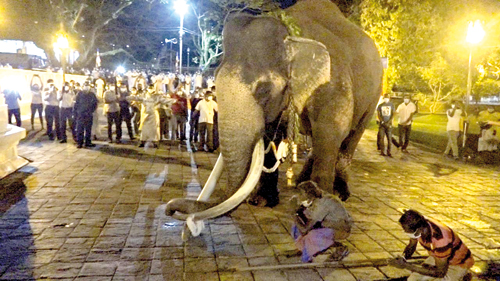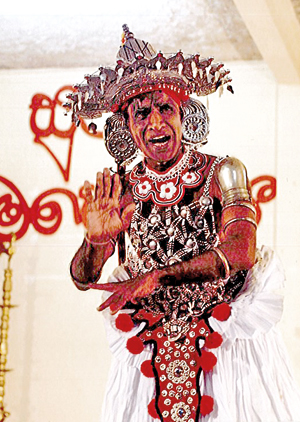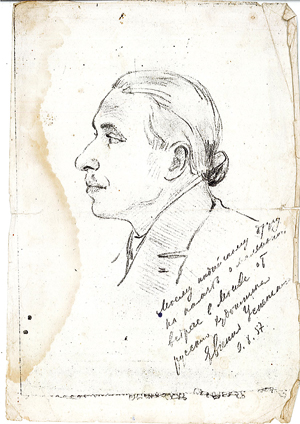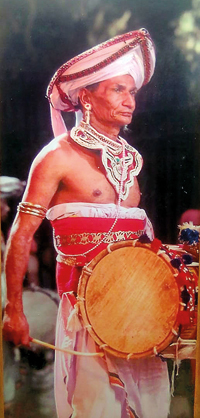The pageant of pageants begins; sans the people

Nadungamuwa Raja: The Tusker who carries the karanduwa paying obeisance on his arrival at the Maligawa. Pic by J. A. L. Jayasinghe
The annual Kandy Esala Perahera or the Mahanuwara Sri Dalada Perahera (pageant), is at present parading the streets of Kandy. Absent though, are the eager crowds who would await this great procession with such devotion and excitement each year. The sound of music and dancing reverberates within the Kandyan hills - but to a deserted city.
The Kumbal Perahera began on August 13 and will continue every night until the 17th. The grand Randoli Perahera will be from the 18th ending on Nikini Full Moon Poya on the 22nd followed by the Daval (day) perahera on the 23rd.
In the past, people from the villages around Kandy and other areas looked forward to attending the perahera. Rain or sunshine, some would come very early to find a place to sit and wait patiently on the pavement until evening, or stand five deep in a prime spot. Unfortunately this year too due to the COVID-19 pandemic, spectators are not permitted to view the Perahera.

Johnny Nittawela: Continuing a long standing family tradition
It is not only the spectators who are disappointed. The artistes too are disheartened as there will be no people to appreciate their performance.
Othenne Panikkiylage Gedera Karunadasa is from the Uduwala Hevisi Paramparawa (drumming lineage) – the fifth generation of drummers in his family. His thattha, attha, muttha and loku thaththa (father, grandfather, great grandfather and uncle) were attached to the Sri Dalada Maligawa Hevisi performance for the Thevawa (service) and perahera. His father, Abittha Panikkaya, born in 1920 continued the Rajakariya (royal duty) as was done by his ancestors by performing in the perahera. They have been given nindagam (land gifted by the king) as a reward for performing in the perahera and the Sri Dalada Maligawa Thevawa.
Abittha Panikkaya initiated his son Karunadasa when he was 12 to their traditional craft of playing drums. Says Karunadasa, “Mama palamuwa pantheruwalata saha thalampotata puruduwuna. Pasuva Daul Beré gahanta igenagaththa,” – he started by learning to play the pantheru, thalampota (cymbals) and then graduated to play the daula drum.
Now 68, Karunadasa is participating in the perahera this year too. He has played the daula in the perahera for the past 50 years but confesses a lack of excitement and enthusiasm this year. “Paluva denenawa, hariyata api horen yanawa wagey, manasikawa vetila, dhairiya aduy – we feel the emptiness. It is as if we are performing stealthily. Mentally, we are fallen and we don’t have the courage,” he says. But we console ourselves thinking and remembering that we perform in honour of the Dalada Hamuduruwo, he adds.
In the years gone by, there were about 80 drummers but this year the number has dwindled to about 50, he says.
Explaining the ending of the Perahera every night, Karunadasa explained the different forms of playing the hevisi at different stages until the karanduwa (golden casket)is replacedin the upper storey of the Sri Dalada Maligawa.

The sketch of Johnny Nittawela’s father Ukkuwa Gurunnanse done by a Russian artist in 1957
“Up to the gate of the President’s House in Raja Veediya we play the tune known as Vali nada hevisi. From that point until we reach the sandakada pahana (moonstone) at the entrance to the Maligawa, we change to another tune, the Pada pahé hevisi drumming. Once we enter the Maligawa we continue drumming in the Ambarava (which is like a tunnel) – the space between the steps and the inner entrance to the Maligawa, until the Diyawadana Nilame removes the karanduwa (golden casket) from the Tusker and takes it up to the upper storey. When the karanduwa is placed in the inner chamber, we change to the Alaththi baeme hevisi drumming and end our performance.”
During the perahera season, Karunadasa and the other drummers do not go for Hevisi drumming at functions in homes. The only other function is the continuation of the Hevisi pooja vadanaya, at the Sri Dalada Maligawa for the Theva duty, which is performed in the morning, mid-day and evening - a daily routine. A group of four from the Uduwela, Molagoda, Malagammana and Ihalawela lineage take part in this ritual of the shabda pooja in honour of the Sacred Tooth Relic of the Buddha. The musical instruments used are two daul bera (drums) horanaewa and the tammettama (drum).
Karunadasa sees his Perahera duties as a sacred trust. Before the start of the perahera the drummers pay homage to the Buddha and make vows to the four Devalas. “During the eleven days of the Perahera, I do not go home, do not eat any kind of meat, I am a vegetarian.”
The daul bera, he said, was used during the time of the Kandyan kings as an ‘Ana bera’ – for the king’s proclamations and to announce his arrival on a journey. The colourfully painted and decorated drum is also used in Buddhist religious rituals. One side of the drum is played with a ‘kadippuwa’ a stick and the other with the hand. When he was young his hand would hurt and karageta (corns) would appear. “Than atha padanwela”, now the hand has got used to it.

Karunadasa: Performing in the Perahera for the past 50 years
Karunadasa’s son O.P. Ravindra Sampath Kumara is trained to continue the tradition of playing the daul beré and take part in the perahera.
Ves dancer Johnny Nittawela, son of Ukkuwa Gurunnanse who is from the Nittawela paramparawa speaks with pride of the contribution made by his ancestors from the time of the Kandyan kings. Suramba Gurunnanse and Nittawela Gunaya Gurunnanse are famous for their dance performances with the latter also credited for creating some Vannam such as the Samanala Vannama.
Johnny Nittawela became a dancing teacher and taught at St. Anthony’s College, Katugastota and after retirement has trained students at Sussex College, Polgolla. Despite his teaching career, he has danced dedicatedly in the perahera every year. He had to learn the “moolika saramba” (physical training) and the 18 vannam before he received the ves bendeema. This year, at the age of 78, he is dancing in the Vishnu Devala Perahera with his brother Sirisena playing the drum.
In 1957, at the age of 15, Johnny travelled to Moscow with his father Ukkuwa Gurunnanse and famed artistes such as Chitrasena,Vajira, Panibharatha, Surasena, Chira Algama and others. A Russian artist had drawn a portrait of his father and presented it to him, and he preserves it to this day.
“Nugawela Diyawaana Nilame Thuma requested Suramba Gurunnanse to perform the Ves dance in the perahera. But he did not like to perform this dance in the Kandy Perahera as it was a ritual for the Devas,” says Johnny. However, with a few other dancers, wearing a Jatawa (head-dress without the Ves Thattuwa) and with polmal in their hands they performed before the Dalada Karanduwa at the request of the Diyawadana Nilame. Later, the full Ves dance was introduced to the perahera.”
He too is despondent over the lack of spectators due to COVID. Although the artistes like to dance, their enthusiasm has dwindled as there are no spectators to appreciate their performance, he laments.
Johnny Nittawela and Karunadasa have received the Kala Bhooshana award in recognition of their contribution to preserve the Kandyan dance and drumming. This year too they strive to ensure the pageant unfolds in its full glory, even if people can only watch on their TV screens.


